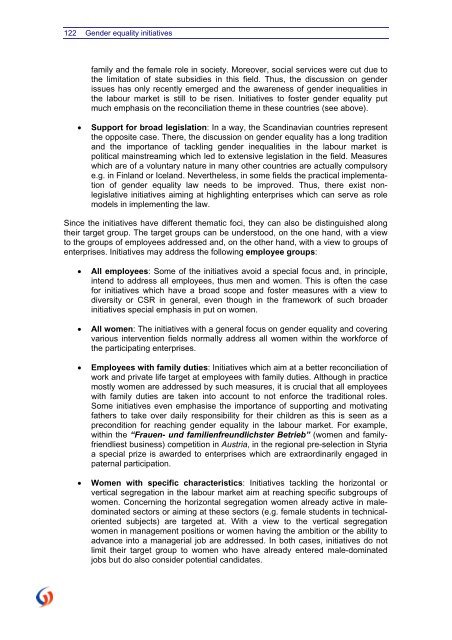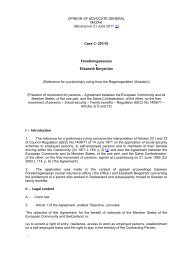Study on non-legislative initiatives for companies to promote gender ...
Study on non-legislative initiatives for companies to promote gender ...
Study on non-legislative initiatives for companies to promote gender ...
Create successful ePaper yourself
Turn your PDF publications into a flip-book with our unique Google optimized e-Paper software.
122 Gender equality <strong>initiatives</strong><br />
family and the female role in society. Moreover, social services were cut due <strong>to</strong><br />
the limitati<strong>on</strong> of state subsidies in this field. Thus, the discussi<strong>on</strong> <strong>on</strong> <strong>gender</strong><br />
issues has <strong>on</strong>ly recently emerged and the awareness of <strong>gender</strong> inequalities in<br />
the labour market is still <strong>to</strong> be risen. Initiatives <strong>to</strong> foster <strong>gender</strong> equality put<br />
much emphasis <strong>on</strong> the rec<strong>on</strong>ciliati<strong>on</strong> theme in these countries (see above).<br />
• Support <strong>for</strong> broad legislati<strong>on</strong>: In a way, the Scandinavian countries represent<br />
the opposite case. There, the discussi<strong>on</strong> <strong>on</strong> <strong>gender</strong> equality has a l<strong>on</strong>g traditi<strong>on</strong><br />
and the importance of tackling <strong>gender</strong> inequalities in the labour market is<br />
political mainstreaming which led <strong>to</strong> extensive legislati<strong>on</strong> in the field. Measures<br />
which are of a voluntary nature in many other countries are actually compulsory<br />
e.g. in Finland or Iceland. Nevertheless, in some fields the practical implementati<strong>on</strong><br />
of <strong>gender</strong> equality law needs <strong>to</strong> be improved. Thus, there exist n<strong>on</strong><strong>legislative</strong><br />
<strong>initiatives</strong> aiming at highlighting enterprises which can serve as role<br />
models in implementing the law.<br />
Since the <strong>initiatives</strong> have different thematic foci, they can also be distinguished al<strong>on</strong>g<br />
their target group. The target groups can be unders<strong>to</strong>od, <strong>on</strong> the <strong>on</strong>e hand, with a view<br />
<strong>to</strong> the groups of employees addressed and, <strong>on</strong> the other hand, with a view <strong>to</strong> groups of<br />
enterprises. Initiatives may address the following employee groups:<br />
• All employees: Some of the <strong>initiatives</strong> avoid a special focus and, in principle,<br />
intend <strong>to</strong> address all employees, thus men and women. This is often the case<br />
<strong>for</strong> <strong>initiatives</strong> which have a broad scope and foster measures with a view <strong>to</strong><br />
diversity or CSR in general, even though in the framework of such broader<br />
<strong>initiatives</strong> special emphasis in put <strong>on</strong> women.<br />
• All women: The <strong>initiatives</strong> with a general focus <strong>on</strong> <strong>gender</strong> equality and covering<br />
various interventi<strong>on</strong> fields normally address all women within the work<strong>for</strong>ce of<br />
the participating enterprises.<br />
• Employees with family duties: Initiatives which aim at a better rec<strong>on</strong>ciliati<strong>on</strong> of<br />
work and private life target at employees with family duties. Although in practice<br />
mostly women are addressed by such measures, it is crucial that all employees<br />
with family duties are taken in<strong>to</strong> account <strong>to</strong> not en<strong>for</strong>ce the traditi<strong>on</strong>al roles.<br />
Some <strong>initiatives</strong> even emphasise the importance of supporting and motivating<br />
fathers <strong>to</strong> take over daily resp<strong>on</strong>sibility <strong>for</strong> their children as this is seen as a<br />
prec<strong>on</strong>diti<strong>on</strong> <strong>for</strong> reaching <strong>gender</strong> equality in the labour market. For example,<br />
within the “Frauen- und familienfreundlichster Betrieb” (women and familyfriendliest<br />
business) competiti<strong>on</strong> in Austria, in the regi<strong>on</strong>al pre-selecti<strong>on</strong> in Styria<br />
a special prize is awarded <strong>to</strong> enterprises which are extraordinarily engaged in<br />
paternal participati<strong>on</strong>.<br />
• Women with specific characteristics: Initiatives tackling the horiz<strong>on</strong>tal or<br />
vertical segregati<strong>on</strong> in the labour market aim at reaching specific subgroups of<br />
women. C<strong>on</strong>cerning the horiz<strong>on</strong>tal segregati<strong>on</strong> women already active in maledominated<br />
sec<strong>to</strong>rs or aiming at these sec<strong>to</strong>rs (e.g. female students in technicaloriented<br />
subjects) are targeted at. With a view <strong>to</strong> the vertical segregati<strong>on</strong><br />
women in management positi<strong>on</strong>s or women having the ambiti<strong>on</strong> or the ability <strong>to</strong><br />
advance in<strong>to</strong> a managerial job are addressed. In both cases, <strong>initiatives</strong> do not<br />
limit their target group <strong>to</strong> women who have already entered male-dominated<br />
jobs but do also c<strong>on</strong>sider potential candidates.
















